By Jody Brumage, Historian and Curator of South Mountain Heritage Society
Until mass-produced furniture became widely available and popular in the late-nineteenth century, many families in the Middletown Valley furnished their homes with chairs, tables, beds, cupboards, and other pieces that they either constructed themselves or commissioned through their local cabinetmaker. The trade of cabinetmaking came to the colonies with European settlers in the seventeenth century. Possessing the skills of joining, carving, and turning among others, cabinetmakers built furniture to the specifications of their customers. Throughout the nineteenth century, cabinetmakers were as common to small towns as blacksmiths, millers, and storekeepers, but only the names of a few have stood the test of time and maintain recognition today among those who collect and preserve furniture made in the Middletown Valley. Many of these cabinetmakers lived and worked in the upper valley around the villages of Myersville and Wolfsville.
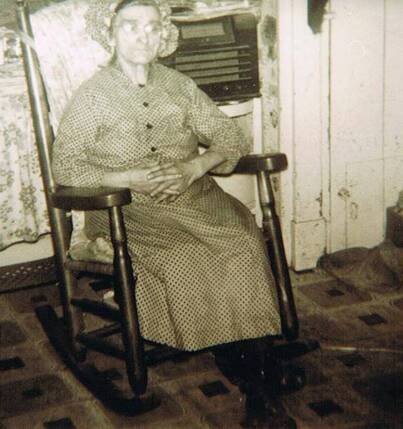
James Wesley Morgan established a furniture factory northwest of Wolfsville in Brandenburg Hollow in 1883 where he built chairs, tables, and cabinets. The site of his establishment is now the Wolfsville Ruritan Club. Calvin Tressler Kinna Gladhill and his wife, Lola Wiles Gladhill of Harmony, established the valley’s premier furniture store in 1915 in Middletown, employing local cabinetmakers in addition to carrying fine furniture imported from catalog companies. Beginning in the 1850s, the Stottlemyers of Wolfsville, perhaps the most well-known of valley cabinetmakers, produced furniture which has come to define the Middletown Valley style. The work of Frederick Stottlemyer and his son, Christopher Columbus Stottlemyer remains highly sought-after nearly a century after their business ceased operation in 1921.
One of the last families engaged in this traditional cabinetmaking trade in the upper valley were the Gavers of Ellerton. Gaver-made furniture is rare given the short period of time in which it was produced. From the early-1930s until 1942, Kellsie Gaver produced cupboards, chairs, bedsteads, and other furniture in his workshop located on his parent’s farm on Bittle Road in Ellerton along Catoctin Creek.
Gaver chairs display many characteristics invoking the style established by Frederick and Christopher Stottlemyer. The shop produced mostly ladderback chairs with sturdy posts anchored in the tops of the runners forming the seat and back. All of the ladderback chairs observed by the author attributed to Gaver have oval-shaped backslats, either rounded on the top or on both the top and bottom of each slat. Stottlemyer chairs used oval backslats in addition to their more well-known scalloped (or heart-shaped) design. The most clear link between Gaver’s work and that of the Stottlemyers are his acorn finials which ornament the top of the chairs’ back posts. The Stottlemyers also made chairs with spherical “cannon-ball” finials or flattened caps without any finials, and according to Fern Stottlemyer, his father Christopher mastered the turning of the acorn finials. Stottlemyer chairs were also occasionally made with woven or caned backs and the author has observed at least two chairs made by Gaver with similar caned backs.
The production of Gaver furniture in Ellerton came to a sudden close in 1942 when the local draft board selected Kellsie Gaver among fifteen men that spring as U.S. involvement in World War II ramped up. He reported to Baltimore on May 22, 1942 where he enlisted as a private in the U.S. Army. He gave his occupation as a “carpenter” on his enlistment record. On June 16, 1943, Kellsie Alvey Gaver, age 32, was killed in action in the Pacific, little more than a month after having entered active duty. He was awarded the Purple Heart and was interred at the National Memorial Cemetery of the Pacific in Honolulu, Hawaii. He never married and did not have any children.
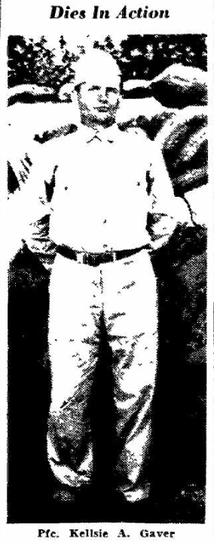
The historic Gaver woodworking shop stands alongside Bittle Road across from the family’s farm in a peaceful glen along Catoctin Creek. For little more than a decade, Kellsie Gaver carried on a historic legacy and characteristic style of Middletown Valley-made furniture which is worthy of preservation and further study.
Acknowledgement: In preparing this short article, I received photographs of several Gaver chairs as well as a family photograph of Kellsie Gaver’s sister, Mary Ethel Virginia Gaver Morningstar, from Lisa Heatherly Montgomery. Her permission to use the photograph of her great grandmother sitting in a chair made by Kellsie Gaver as well as photographs of additional chairs which supported my research is greatly appreciated.
Additional information about the Gavers was furnished by the Wiles Family from whom I purchased my Gaver rocking chair.
CORRECTIONS: On 28 December, 2020, we received this email from Charles E. Wiles. Jr., "I am the son of Charles Wiles. Sr., Kellsie Gaver's nephew. [The] lady in rocker is Lula Gaver, who was Kellsie's mother, and my father's grandmother. Also, the stream that runs through the farm is Middle Creek, not Catoctin Creek."
Cottingham, David, “Main Street,” The Daily Mail (Hagerstown), August 21, 1971.
“Dies in Action,” The Post (Frederick), June 28, 1943.
“Induction Notices Sent Registrants,” The News (Frederick), May 11, 1942.
“Public Auction,” The News (Frederick), February 27, 1971.
“Public Sale,” The Morning Herald (Hagerstown), April 19, 1944.
“Public Sale,” The News (Frederick), November 7, 1951.
“Pvt. Gaver Reported Killed,” The Baltimore Sun, June 6, 1943.
Savitt, Robert P. Middletown Valley. Charleston: Arcadia Publishing, 2010.
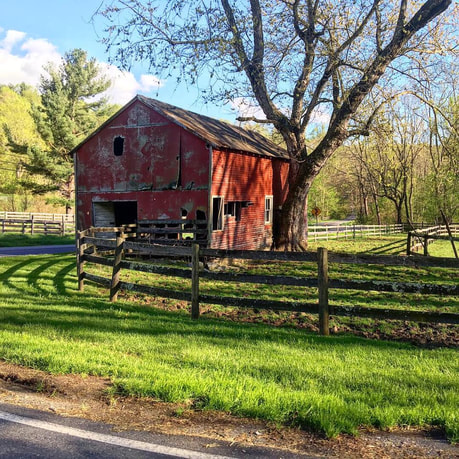
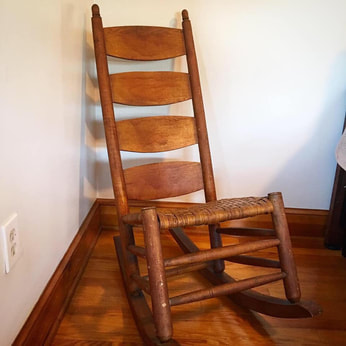
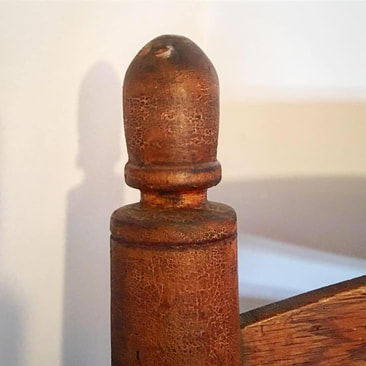
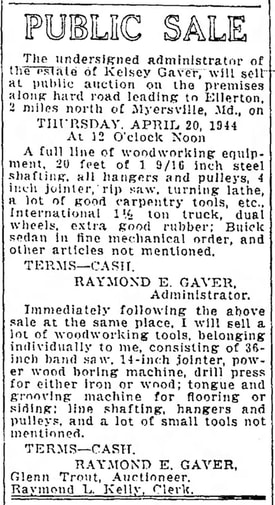
 RSS Feed
RSS Feed